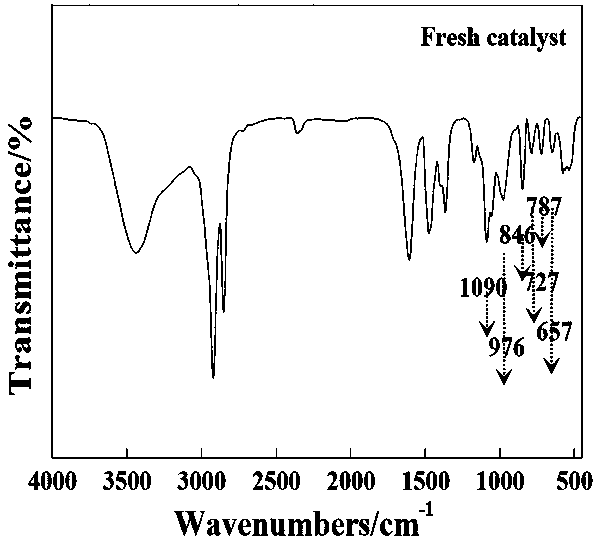Phosphotungstic heteropolyacid salt catalyst for synthesizing epoxy chloropropane and preparation method thereof
A technology of phosphotungstic heteropoly salt and epichlorohydrin, which is applied in the field of catalytic chemistry, can solve the problems that the conversion rate of propylene is only 93% and unfavorable production, and achieve the effects of convenient catalyst recovery, low production cost and safe raw materials
- Summary
- Abstract
- Description
- Claims
- Application Information
AI Technical Summary
Problems solved by technology
Method used
Image
Examples
Embodiment 1
[0014] Add 1.152 kg of solid phosphotungstic acid and 1.7 L of 30% hydrogen peroxide into a 5 L glass reactor, and stir at room temperature in the dark. At the same time, 0.727 kg of dimethyl dioctadecyl ammonium chloride and 8 L of absolute ethanol were added to a 50 L glass reactor, and heated to dissolve at 40°C. After 2 hours, the peroxyphosphotungstic acid solution obtained in the 5 L glass reactor was added dropwise to the 50 L glass reactor with a metering pump. After the addition was completed, the stirring reaction was continued at 40°C for 2 h. After the reaction, cool to room temperature and filter under reduced pressure to obtain a crude catalyst white powder. Wash the white powder with 40 L of distilled water, then wash with 10 L of ethanol, filter, and vacuum-dry at 40°C for 6 h to obtain a white catalyst powder totaling 1.776 kg.
Embodiment 2
[0016] Add 1.152 kg of solid phosphotungstic acid and 1.7 L of 30% hydrogen peroxide into a 5 L glass reactor, and stir at room temperature in the dark. At the same time, 0.727 kg of dimethyl dioctadecyl ammonium chloride and 8 L of absolute ethanol were added to a 50 L glass reactor, and heated to dissolve at 45°C. After 2 hours, the peroxyphosphotungstic acid solution obtained in the 5 L glass reactor was added dropwise to the 50 L glass reactor with a metering pump. After the addition was completed, the stirring reaction was continued at 45°C for 2 h. After the reaction, cool to room temperature and filter under reduced pressure to obtain a crude catalyst white powder. Wash the white powder with 40 L of distilled water, then wash with 10 L of ethanol, filter, and vacuum-dry at 40°C for 6 h to obtain a white catalyst powder totaling 1.764 kg.
Embodiment 3
[0018] Add 1.152 kg of solid phosphotungstic acid and 1.7 L of 30% hydrogen peroxide into a 5 L glass reactor, and stir at room temperature in the dark. At the same time, 0.727 kg of dimethyl dioctadecyl ammonium chloride and 8 L of absolute ethanol were added to a 50 L glass reactor, and heated to dissolve at 50°C. After 2 hours, the peroxyphosphotungstic acid solution obtained in the 5 L glass reactor was added dropwise to the 50 L glass reactor with a metering pump. After the addition was completed, the stirring reaction was continued at 50°C for 2 h. After the reaction, cool to room temperature and filter under reduced pressure to obtain a crude catalyst white powder. Wash the white powder with 40 L of distilled water, then wash with 10 L of ethanol, filter, and vacuum-dry at 40°C for 6 h to obtain a white catalyst powder totaling 1.730 kg.
PUM
 Login to View More
Login to View More Abstract
Description
Claims
Application Information
 Login to View More
Login to View More - R&D Engineer
- R&D Manager
- IP Professional
- Industry Leading Data Capabilities
- Powerful AI technology
- Patent DNA Extraction
Browse by: Latest US Patents, China's latest patents, Technical Efficacy Thesaurus, Application Domain, Technology Topic, Popular Technical Reports.
© 2024 PatSnap. All rights reserved.Legal|Privacy policy|Modern Slavery Act Transparency Statement|Sitemap|About US| Contact US: help@patsnap.com










